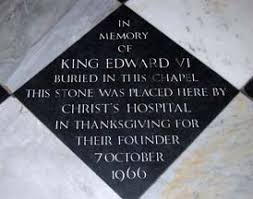
The Records of the Lord Chamberlain show that Edward’s public funeral resembled Henry’s own (though Henry’s bier traveled from Whitehall to Windsor while Edward’s went from Greenwich to Westminster). The procession involved “a great company” of children dressed in surplices, singing clerks, Edward’s former servants carrying his heraldic banners, heralds, henchmen, and the chariot carrying his coffin. This chariot, with its blue velvet canopy, was pulled by seven horses and decorated with cloth of gold – going slowly so as not to disturb Edward’s effigy. Said to be lifelike, it sat atop the coffin wearing his crown and garter collar and holding a scepter (it even had his garter ribbon tied around its leg). As the cortege passed through London, the sight caused the crowds to turn “wepyng and lamenting.” It was met at Westminster Abbey by Thomas Cranmer, Archbishop of Canterbury, who presided over the service using the reform rite that Edward had approved in 1552.
But unlike Henry, Edward had another funeral, a private one.
Mary thought her brother needed a Latin Mass, for the “salvation of his soul.” This of course led to a bit of understandable pushback from the Council, whose members generally agreed that the boy king should be buried in accordance with the faith in which he had lived. Since Mary would not be attending (it was not customary for a new monarch to attend the old one’s funeral), she agreed to allow her brother this courtesy…though she did insist on having Latin Masses celebrated for him at the Tower.
The incident was telling – it was a clear signal to anyone paying attention that she would try to roll back her brother’s reforms. But just as the country in 1536 had no idea how far Henry would go when he closed his first monastery, the country in 1553 was uncertain how much Mary would or could pull. But we know where she was headed, thanks to the way the smug Spanish Ambassador described the incident to Charles:
“The obsequies of the late King Edward will be carried out as the Council shall decide. The Queen will not be present, but will have a plain office sung at the castle (i.e. the Tower), beginning to-day at vespers. This is done with the consent and approval of the Council, and mass is to be said henceforth every day in the chapel of the castle, and in such places as she may find herself in, though no proclamation is to be made concerning the liberty to hear mass, and the remedy of religious matters, by means of the Parliament or otherwise, is to wait for the sanction of time. The Bishop of Winchester will officiate, as we have been informed. The body is to be buried to-morrow. The difficulty foreseen in your Majesty’s letters, that would attend any undue haste on her part in matters of religion, has been by mature consideration examined and disposed of, with the object of avoiding the said difficulties and dangers and so encompass eventually a better and more complete reform.”
https://www.british-history.ac.uk/cal-state-papers/spain/vol11/pp150-162
The Boy King ends before this point (it ends when he dies). While I did give Mary the epilogue (she is a point-of-view character after all), this story is firmly part of her new reign. But don’t worry, I’ll cover it in my Regina (Elizabeth) trilogy… 😉
***
If you like my posts, you’ll love my books! My Seymour Saga trilogy tells the gripping story of the short-lived dynasty that shaped the Tudor Era. Jane the Quene skews romantic, The Path to Somerset is pure Game of Thrones (without the dragons), and The Boy King is a noir coming-of-age. Get them now through Amazon, Barnes & Noble, Kobo, and Apple, or even your local independent bookstore!

(PS Already read them? Did you love them? Then please review them – even just a stars rating! It makes a huge difference in helping new readers find them and would mean the world to me!)

Be First to Comment